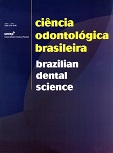Polyurethane and PTFE barriers for guided bone regeneration: A hismorfometric study in rabbits parietal bone
DOI:
https://doi.org/10.14295/bds.2008.v11i4.654Resumo
The purpose of this study was to evaluate the process of bone repair in surgical defects created in parietal bone of rabbits by the guided bone regeneration technique, using polyurethane (PUr) and PTFE barriers. The surface characteristics of the barriers in scanning electronic microscopic were also evaluated. In this research, 24 adult rabbits were used, 12 were in control group (C) and 12 were in experimental groups (right parietal – PUr group and left parietal – PTFE group). In the C group, the defect was filled only by blood clot. In the experimental groups, the PUr and PTFE barriers were positioned on the floor and on the surface of each bone defect. After 15, 30, 60 and 90 days, 3 animals in the C and 3 in the experimental groups were sacrificed and the defect bones were submitted to microscopic analysis. The results of the study showed no significant differences in the experimental groups, demonstrating quantitative and qualitative superiority bone fill and faster bone regeneration when compared to the C group. The physical barriers presented homogenous surface and no porosity. The PUr was biocompatible, osteoconductive and was not absorbed during the process of bone repair.
Downloads
Downloads
Publicado
Como Citar
Edição
Seção
Licença
TRANSFERÊNCIA DE DIREITOS AUTORAIS E DECLARAÇÃO DE RESPONSABILIDADE
Toda a propriedade de direitos autorais do artigo "____________________________________________________________________" é transferido do autor(es) para a CIÊNCIA ODONTOLÓGICA BRASILEIRA, no caso do trabalho ser publicado. O artigo não foi publicado em outro lugar e não foi submetido simultaneamente para publicação em outra revista.
Vimos por meio deste, atestar que trabalho é original e não apresenta dados manipulados, fraude ou plágio. Fizemos contribuição científica significativa para o estudo e estamos cientes dos dados apresentados e de acordo com a versão final do artigo. Assumimos total responsabilidade pelos aspectos éticos do estudo.
Este texto deve ser impresso e assinado por todos os autores. A versão digitalizada deverá ser apresentada como arquivo suplementar durante o processo de submissão.




























